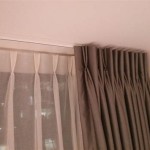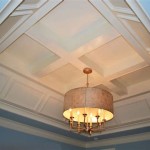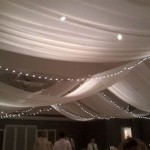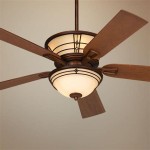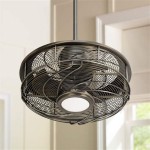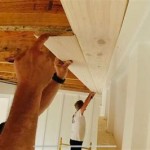How to Remove Water Stains From Popcorn Ceiling Without Painting
Popcorn ceilings, also known as acoustic ceilings, were a popular choice in residential construction for many years due to their sound-dampening properties and ability to hide imperfections. However, one significant drawback of this type of ceiling is its vulnerability to water damage. Water stains on a popcorn ceiling are unsightly and can indicate a more serious problem, such as a roof leak or plumbing issue. While painting the entire ceiling might seem like the only solution, it's often possible to remove the water stain without resorting to such a drastic measure. This article provides a comprehensive guide on how to achieve this, focusing on techniques that preserve the original texture and appearance of your popcorn ceiling.
Before beginning any cleaning process, it's crucial to identify and address the source of the water leak. Cleaning the stain without fixing the underlying problem will only result in the stain reappearing. Inspect the roof, plumbing, and any other potential sources of water intrusion. Engage a professional for repairs if necessary. Once the leak is resolved, you can proceed with stain removal.
The success of removing a water stain without painting depends on several factors, including the severity of the stain, the age of the ceiling, and the type of popcorn texture. Fresh, light stains are generally easier to remove than old, dark stains. Older ceilings may be more fragile and require a gentler approach. Be prepared to test different methods and exercise patience throughout the process.
Assessing the Damage and Gathering Supplies
The first step in removing a water stain is to carefully assess the extent of the damage. Observe the size, color, and depth of the stain. A light, yellowish stain indicates a relatively recent and minor leak, while a dark brown or black stain suggests a more significant and long-standing problem. Note any signs of mold or mildew growth, as these require specific treatment. Gently touch the affected area to check for softness or crumbling, which indicates the ceiling material has been significantly compromised.
Once you've assessed the damage, gather the necessary supplies. You'll need:
- A soft-bristled brush (such as a paintbrush or a dusting brush)
- A vacuum cleaner with a hose attachment and a brush nozzle
- A spray bottle filled with clean, lukewarm water
- A solution of mild dish soap and water (optional, for stubborn stains)
- A solution of hydrogen peroxide and water (optional, for mold or mildew)
- A clean, dry cloth or sponge
- Safety goggles and a dust mask
- A stepladder or stable platform to reach the ceiling
Safety is paramount when working with popcorn ceilings. The material can contain asbestos, especially in older homes built before the 1980s. If you suspect your ceiling contains asbestos, it is strongly recommended to consult with a professional asbestos abatement company before attempting any cleaning or removal. Disturbing asbestos-containing materials can release harmful fibers into the air, posing a serious health risk. Even if you're unsure about the presence of asbestos, it's prudent to wear a dust mask and safety goggles to protect yourself from dust and debris.
Gentle Cleaning Techniques for Light Stains
For light, recent water stains, a gentle cleaning approach is often sufficient. Start by vacuuming the affected area with the brush nozzle attachment. This will remove any loose dirt, dust, or debris that may be contributing to the stain. Hold the nozzle slightly away from the ceiling to avoid dislodging the popcorn texture.
Next, lightly mist the stained area with clean, lukewarm water using the spray bottle. Avoid saturating the ceiling, as excessive moisture can worsen the damage. The goal is to slightly dampen the stain, not to soak it. Allow the water to sit for a few minutes to loosen the stain.
Using the soft-bristled brush, gently dab at the stain. Avoid scrubbing, as this can damage the popcorn texture and spread the stain. Work in a circular motion, applying light pressure to lift the stain. Periodically wipe the brush clean with a dry cloth to prevent transferring the stain back to the ceiling.
Repeat the misting and dabbing process as needed, allowing the area to dry slightly between applications. Be patient and avoid using excessive force. If the stain persists, you can try a mild dish soap solution. Mix a few drops of dish soap with warm water in a separate spray bottle. Apply the soapy solution sparingly to the stain, and then gently dab with the brush. Rinse the area with clean water by lightly misting and blotting with a clean cloth.
Once you've finished cleaning, allow the area to dry completely. This may take several hours or even overnight. Ensure adequate ventilation in the room to facilitate drying. Avoid touching or disturbing the ceiling while it's drying.
Addressing Stubborn Stains and Mold/Mildew
If the water stain is particularly stubborn or has been present for a long time, more aggressive cleaning methods may be necessary. However, proceed with caution, as these methods can potentially damage the popcorn texture.
For persistent stains, consider using a solution of hydrogen peroxide and water. Hydrogen peroxide is a mild bleaching agent that can help to lighten the stain. Mix equal parts of hydrogen peroxide and water in a spray bottle. Apply the solution sparingly to the stain, and allow it to sit for a few minutes. Then, gently dab with the soft-bristled brush and blot with a clean cloth. Rinse the area with clean water and allow it to dry completely.
If you notice signs of mold or mildew growth on the popcorn ceiling, it's crucial to address this issue promptly. Mold and mildew can pose health risks and can also cause further damage to the ceiling. Before applying any cleaning solution, ensure the area is well-ventilated. Wear a dust mask and gloves to protect yourself from spores.
To treat mold or mildew, mix a solution of one part bleach and ten parts water in a spray bottle. Apply the solution to the affected area and allow it to sit for a few minutes. Then, gently scrub with the soft-bristled brush and blot with a clean cloth. Rinse the area with clean water and allow it to dry completely. Be cautious when using bleach, as it can discolor the ceiling. Test the solution on an inconspicuous area first to ensure it doesn't cause any adverse effects.
An alternative to bleach is to use a mold and mildew cleaner specifically formulated for porous surfaces. Follow the manufacturer's instructions carefully. These cleaners are often less harsh than bleach and may be more effective at removing mold and mildew from popcorn ceilings.
After treating mold or mildew, it's essential to address the underlying cause of the moisture problem. Identify and repair any leaks or sources of dampness. Improve ventilation in the room to prevent future mold or mildew growth.
Repairing Minor Damage to Popcorn Texture
In some cases, the cleaning process may cause minor damage to the popcorn texture, such as small flakes or pieces falling off. It's possible to repair these minor imperfections without re-texturing the entire ceiling.
You can purchase a small can of popcorn ceiling texture repair spray from most home improvement stores. These sprays are designed to match the existing texture and can be applied to small areas to fill in gaps or repair damage. Before applying the spray, clean the area and remove any loose debris.
Shake the can of texture repair spray thoroughly and hold it approximately 12 inches from the ceiling. Apply the spray in short, even bursts, being careful not to oversaturate the area. Allow the texture to dry completely, which may take several hours. If necessary, apply a second coat to achieve the desired texture.
Once the texture is dry, you can blend it in with the surrounding ceiling by gently dabbing with a clean, dry cloth or sponge. This will help to soften the edges and create a more seamless appearance.
If you can't find a texture repair spray that matches your existing ceiling texture, you can create your own by mixing joint compound with water to a thick, creamy consistency. Apply the mixture to the damaged area using a putty knife or a small trowel. Use a sponge or brush to create a texture that matches the surrounding ceiling. Allow the mixture to dry completely and then paint to match the existing ceiling color, if necessary.
Removing water stains from popcorn ceilings without painting requires patience, caution, and a gentle approach. By carefully assessing the damage, gathering the necessary supplies, and using appropriate cleaning techniques, it's often possible to restore the ceiling to its original appearance. Remember to address the underlying source of the water leak to prevent future stains. If you're unsure about any step of the process or suspect the presence of asbestos, consult with a professional.

Super Easy Way To Remove Water Stains From Ceilings Without Paint 1 Step Abbotts At Home

Popcorn Ceiling How To Remove An Ugly Stain Drywall Repairman Water Damage Repair

How To Remove Water Stains From Popcorn Ceiling At Home Without Paint Homax Texture Spray

Super Easy Way To Remove Water Stains From Ceilings Without Paint 1 Step Abbotts At Home

Super Easy Way To Remove Water Stains From Ceilings Without Paint 1 Step Abbotts At Home

How To Fix Water Stains On Ceiling Leaks Super Easy Steps Abbotts At Home
How To Quickly Easily Remove Water Stains On Your Ceiling Without Painting Melanie Lissack Interiors

We Have An Old Water Stain On Our Ceiling How Do I Cover It Hometalk

Super Easy Way To Fix Water Stains On Ceiling Or Wall Without Painting It

The Joy Of Popcorn Ceiling Removal Centsational Style
Related Posts

